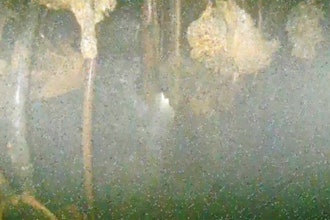
Toxic fluids used in drilling and hydraulic fracturing likely escaped an unlined borehole and migrated thousands of feet into a residential drinking-water supply in Pennsylvania, according to a study published Monday.
At least three water wells in Bradford County, located in the heart of the Marcellus Shale drilling boom, were found to be contaminated with dangerous levels of methane and other substances in 2010. The incident was one of several involving Chesapeake Energy that prompted state environmental regulators to levy a record $1 million fine against the driller in May 2011.
Penn State University researchers detected in one of the water wells a minute amount of a chemical compound often found in drilling and fracking fluids, according to the study, published in the Proceedings of the National Academy of Sciences. The compound, 2-BE, has a wide variety of industrial and household uses, and is commonly found in paint, cosmetics and cleaners, but the authors identified gas drilling as the most probable source.
"This is the first documented and published demonstration of toxic compounds escaping from uncased boreholes in shale gas wells and moving long distances" into drinking water, said Susan Brantley, one of the study's authors.
The contamination took place before Pennsylvania enacted stricter standards for gas well construction in 2011. Brantley and a co-author, David Yoxtheimer, said the newer regulations might have prevented it.
Researchers did not implicate the fracking technique itself. Hydraulic fracturing, or fracking, involves the high-pressure injection of millions of gallons of water, along with sand and chemical additives, deep underground to break apart shale rock and free the gas trapped inside it. The industry and many federal and state officials say fracking is safe when done properly, but environmental groups contend the risk of contamination is too great.
The tainted water in the residential wells almost certainly did not migrate upward from the Marcellus — a rock formation more than a mile underground — after fracking, Brantley said. The fluid did not contain a high level of salt, a signature of fracking wastewater.
Instead, it's likely that drilling fluid escaped the borehole while crews were first drilling the gas well, Brantley and Yoxtheimer said. Another possibility, though one the researchers consider less likely, is that it stemmed from a leaky drilling waste pit.
"The new results are consistent with what we've found in the Marcellus and in the Barnett," a shale gas field in Texas, said Rob Jackson, a Stanford University environmental scientist not involved in the study. "Problems are especially likely where you combine poor well integrity with shallow bedrock fractures."
The Marcellus Shale Coalition said the researchers did not prove that gas drilling put 2-BE in the water well. The trade group also said the industry is getting better at protecting water supplies.
"It's absolutely critical to acknowledge that important technological advancements have been and continue to be made, along with the fact that Pennsylvania's regulations were dramatically strengthened over the past several years ... aimed at protecting groundwater, which is a top industry priority," Travis Windle, a spokesman, said in a statement.
The three homeowners whose wells were tainted sued Chesapeake. The gas company, while denying culpability, bought their properties near Wyalusing as part of a $1.6 million settlement.






















